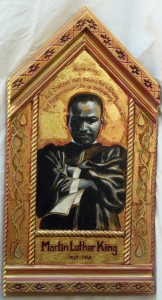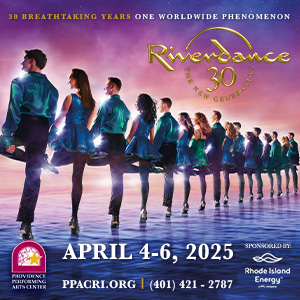 The current exhibit at the URI campus includes, “Civil Rights Are Human Rights: Icons of the Civil Rights Movement,” which is a contrast in approach and focus. Pamela Chatterton-Purdy’s iconic memorials reflect a solemn reverence for those whose lives were impacted, and too often ended, by our country’s civil rights struggle. Jordan Seaberry’s gritty street scenes in his exhibit, “A Blacker Landscape,” show the harshly worn points of impact where the virus of oppression has struck. The reality of being black in America is fully represented in this collection celebrating Black History Month.
The current exhibit at the URI campus includes, “Civil Rights Are Human Rights: Icons of the Civil Rights Movement,” which is a contrast in approach and focus. Pamela Chatterton-Purdy’s iconic memorials reflect a solemn reverence for those whose lives were impacted, and too often ended, by our country’s civil rights struggle. Jordan Seaberry’s gritty street scenes in his exhibit, “A Blacker Landscape,” show the harshly worn points of impact where the virus of oppression has struck. The reality of being black in America is fully represented in this collection celebrating Black History Month.
It is rare that the URI Gallery features only two artists, but each of these artists brought a full community of souls along with them, and each one of their pictures shows a multitude of stories. It is in the collective whole that both the unbreakable dignity, and the horror, of black history in America is told.
Chatterton-Purdy’s shrines are quiet, but the gold leaf coating their hard frames oozes blood from the cracks of their well-rubbed veneers. Every wood and found object used to build them is sacred, “a holy tablet, a monument, a bridge, a cross, maybe even a headstone,” Chatterton-Purdy describes. Symbolism is deftly woven into the artist’s choice of materials. She is quoted in written materials about her exhibit: ”You will see yard sticks cut off at number 14, the age that Emmett Till’s life was taken. You will see pieces of a children’s chess set. You will also see verses from Scripture. One of Dr. King’s favorite passages was from the prophet Amos (5:24) ‘Let justice roll down like water and righteousness like an ever flowing stream.’” Chatterton-Purdy was working at Ebony Magazine when Dr. Martin Luther King was assassinated. Both she and her husband, David, a Methodist minister, became part of the lifelong struggle for civil rights, a dedication that has lasted throughout their marriage. This collection is one that the viewer can become lost in, each story piquing viewers’ curiosity for the next. A compassionate picture emerges, illustrated by the faces and lives of more than 30 figures of the Civil Rights Movement.
Seaberry’s paintings hit closer to home. These are visions of the world of Now, a world that continues on the streets today. As the director of public policy and advocacy at the Institute for The Study and Practice of Non-Violence in Providence (ISPN), Seaberry is very familiar with this world. He came to RI from Chicago’s Southside to attend Rhode Island School of Design. By his junior year, his involvement with the Providence social justice community had overtaken his studies. He left RISD to teach art for after-school programming, helping out at the Southside Boys and Girls Club and working as the prisoners’ rights organizer at Direct Action for Rights and Equality. As an organizer, he fought for criminal justice reform milestones, including 32(f) Probation Violation Reform, the Unshackling Pregnant Prisoners Bill. Charged with a mission, he returned to RISD to finish his painting degree, then put his experience to work using art to shine a light on the realities of our city streets. Today, Jordan is enrolled at Roger Williams University Law School while he continues to work with the community and impact public awareness with his art.
Gallery curator Steven Pennell pointed out an eerie Seaberry painting at the top of the stairs on the 2nd floor of the URI Gallery. It shares something of the iconic timeless quality of Chatterton-Purdie’s work – a simple tableau featuring three men hanging out on the steps of a house. It would be a normal scene of gathered friends … except for the fact that all three of them are missing their heads.
The URI Providence Campus Urban Arts and Culture Program exhibit, CIVIL RIGHTS ARE HUMAN RIGHTS: Icons of the Civil Rights Movement by Pamela Chatterton Purdy & A Blacker Landscape by Jordan Seaberry will be on display through Feb 28.

